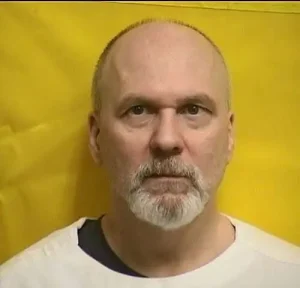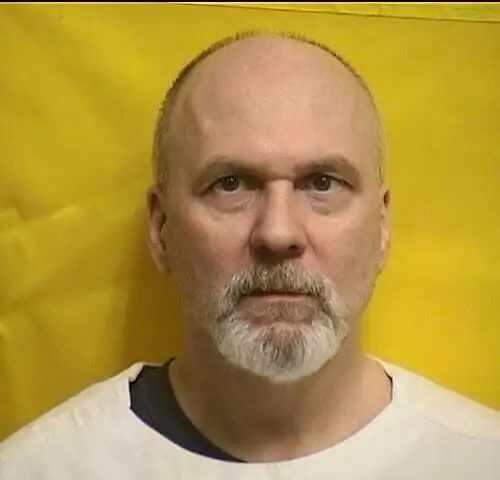Warren Henness was sentenced to death by the State of Ohio for the murder of Richard Myer
According to court documents Warren Henness would call Richard Myer over to his home under the pretense of addiction counseling however when Myer arrived he would be murdered and robbed
Warren Henness would be arrested, convicted and sentenced to death
Warren Henness Photos

Warren Henness Now
Number
A287375
DOB
10/13/1963
Gender
Male
Race
White
Admission Date
01/27/1994
Institution
Chillicothe Correctional Institution
Status
INCARCERATED
Warren Henness Case
Henness was convicted of aggravated murder with specifications and sentenced to death for killing Richard Myers, a fifty-one-year-old laboratory technician from Circleville, Ohio.1 On the morning of March 20, 1992, Myers told his wife that he had something to do before he reported to work at midnight. Although he did not elaborate, his wife knew that he was an Alcoholics Anonymous volunteer and frequently traveled to Columbus to counsel others about drug and alcohol addictions. When his wife returned home from work that afternoon, Myers was not there. He also failed to report to work that evening.
That same morning, Henness’s wife, Tabatha, answered a telephone call at Robert Curtis’s residence, where she and Henness were staying. The caller identified himself as “Dick” and asked for Henness. After the phone conversation ended, Henness told Tabatha he was going out. A car subsequently arrived for him. Tabatha recognized the driver as “Dick,” a man who had picked up Henness several other times in the same vehicle.
A few hours later, Henness returned to the residence to pick up Tabatha. He was alone and driving Myers’s car. The couple drove to a carwash and smoked crack. In his possession, Henness had checks and credit cards belonging to Myers. Tabatha suggested that they contact Roland Fair, a drug dealer acquaintance, to pose as Myers to “po [p] the checks” and “play on the credit cards.”
The next day, Henness and Tabatha drove to Fair’s apartment. Henness told Fair that the owner of the checks, credit cards, and car was in a motel room with two prostitutes who were keeping him drunk. While at Fair’s apartment, Tabatha saw Henness washing a knife in the bathroom sink. Later, Fair noticed the knife soaking in the sink. The knife had a dark stain on it. Henness told Fair that it was his knife.
Henness, Tabatha, and Fair traveled to several banks and check-cashing outlets for two days, uttering forged checks and getting cash advances with the credit cards. They used the money to buy drugs. They also used the credit cards to buy merchandise, which they then sold for more drugs.
At some point during this activity, Tabatha suggested that Henness tell Fair the truth about Myers. According to Tabatha, Henness told Fair that the owner of the car, checks, and credit cards had pulled a gun on him, Henness shot him, “and the guy died.” According to Fair, Henness never specifically said what he did to Myers, but he did say, “I did not want to do it. He made me do it.” Later, Henness told Fair that the body was in the Nelson Road area in Columbus. The trio discussed possible ways to dispose of it.
A few days later, Tabatha saw Henness with a gold wedding ring that was too big for him. Henness told her it was Myers’s ring. Henness also sold Myers’s car to a sixteen-year-old drug dealer for $250. Henness forged a bill of sale and signed it “Richard Myers.” The following day, the police recovered the car and impounded it because its owner was reported missing. The police questioned the sixteen-year-old, who told them about Henness.
On March 25, the police received an anonymous telephone call alerting them to the body of a dead man in an abandoned water purification plant. There, police discovered the body of Myers. His shoe laces were tied together, his mouth was gagged, and his hands were bound together behind his back with a coat hanger. They found four shell casings and one live round near his body. The four casings were all ejected from the same weapon. Myers had been shot five times in the head. One bullet had penetrated his brain, killing him. He had a large cut on his neck. Abrasions on his knees showed that his knees had struck a hard surface, and were consistent with being forced to kneel on a concrete floor. Myers’s left ring finger had been severed six to eight hours after death.
Columbus police arrested Henness on an unrelated charge. Because he was also a suspect in Myers’s murder, homicide detectives questioned him. During the interrogation, Henness claimed Fair approached him with the checks and credit cards, and suggested that Fair may have committed the murder. Henness also told detectives he had not owned a gun since 1990. However, Tabatha and Curtis testified that Henness had a handgun that he sold to a drug dealer about two weeks after Myers’s murder.
Henness was later interrogated for a second time. He admitted he was with Myers on March 20, and Myers was helping him seek drug counseling and treatment for Tabatha. He also admitted that Fair was not involved in the murder. Instead, he blamed the murder on some Cubans who were trying to settle a score with him. He stated Myers happened to be at the wrong place at the wrong time.








